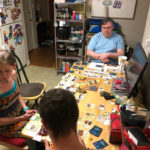It won’t be any sort of surprise that a family that has weekly board game nights plays one of the most popular board games on this planet or any other (as far as we know). Terraforming Mars is a long time staple of ours. It’s easy and fun to play, can take as many people as you can throw at it, and is pretty fast moving to boot.
We hadn’t played it for awhile, but at one time we would alternate between Terraforming Mars, Vast and Magic: the Gathering. We’ve since gone much, much deeper into board gaming, but we still make time for the old favorites.

In Terraforming Mars, humanity has landed on the Red Planet, but Mars is absolutely inhospitable to human life. The soil is poisonous, the gravity is a third of Earth’s, the air is just this side of a hard vacuum and what there is, is not breathable, and the unfiltered solar radiation bakes anything not covered with the talcum powder-like dust.
Players each play a Corporation founded and dedicated to making Mars a second home for humanity. Each corporation approaches this in their own way — some focus on huge, solar system-shattering space projects, others on adapting Terran microbes, plants and animals to Martian conditions, other to making domed cities, etc. Using your hand of cards, you build an economic engine to further your corporate goals, hinder the goals of your opponents, be the first to hit various milestones, and in general dominate whatever hemisphere of Mars you happen to be playing on.
The board is one face of Mars. Expansions open up the other hemisphere, as well as Venus, Mercury, the Moon and eventually the moons of the outer planets. Players play cards or spend Mega Credits to build on Mars or to in other ways increase its habitability.

Two (or more, depending on expansions) graphs determine the state of the game. When the temperature and oxygen level graphs are maxed out (and the Venus graph if playing with the Venus Next expansion), and all the ocean tiles are placed, the game is over.
Each player then totals up their Terraforming points, cities, forests touching cities, milestones, and awards to determine whose corporation had done the most to make Mars a verdant, green planet over the preceding dozen or so generations (as each move is called).
I lost, unfortunately. My corporation was tuned to collecting victory points, which I thought would land me the win. But I didn’t get the early cards I needed to get a good engine rolling, and my secondary plans to green Mars never really got off the ground. I did manage to crash Mars’ smaller moon, Deimos, into the planet, so that was fun. Drew focused on big space projects, Ally was working hard on the terraforming points, and Tom built cities (and scored whenever anyone else built a city as well), which eventually game him the win.
With the “stay at home” orders relaxed here, we’re probably going to go back to our weekend board game nights as well. I think we’re doing Magic: the Gathering this weekend.


